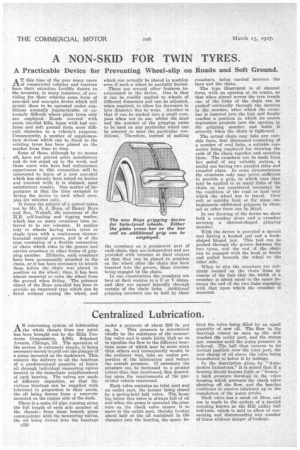A NON-SKID FOR TWIN TYRES.
Page 52

If you've noticed an error in this article please click here to report it so we can fix it.
A Practicable Device for Preventing Wheel-slip on Roads and Soft Ground.
AT this time of the year many users of commercial vehicles and tractors have their attention forcibly drawn to the necessity, in many instances, of providing for their vehicles some form of non-skid and non-spin device which will permit them to be operated under conditions normally impracticable or extremely difficult where plain tyres only are employed. Roads covered with snow, ice-clad hills, lanes with bad surfaces and soft ground form most difficult obstacles to a vehicle's progress. Consequently, a number of supplementary devices which can be fitted to the existing tyres has been placed on the market from time to time.
Some of these, although by no means all, have not proved quite satisfactory and do not stand up to the work, and those users who have had unfortunate experiences in this connection will be interested to learn of a new non-skid -which has already been tested on lorries and tractors with, it is claimed, most satisfactory results. One matter of importance is that the time occupied in fitting the device to each wheel occupies six minutes only.
It forms the subject of a patent taken out by Mr. S. J. Boys, of Henry Boys and Son, Walsall, the patentees of the H.B. self-loading and tipping trailer, which has on many occasions been referred to in our columns. It applies only to wheels having twin tyres or single tyres with a continuous circumferential central groove, and is of the type consisting of a flexible connection or chain which rides in the groove and carries crossbars or other forms of gripping member. Hitherto, such crossbars have been permanently attached to the chain, or it has been necessary to attach them before the chain was placed in Position on the wheel; thus, it has been almost essential to raise the wheel from the ground when fitting. The primary object of the Boys non-skid has been to provide an improved type which can be fitted without raising the wheel, and which can actually be placed in position even if such a wheel be partially buried.
There are several other features incoborated in the device. One is that it can be readily applied to wheels of different diameters and can be adjusted, when required, to allow for decreases in tyre diameter due to wear. Another is that it can be packed into a small compass when not in use, whilst the kind and the number of the gripping units to be used on any particular wheel can be selected to meet the particular conditions. Therefore, instead of making the crossbars as a permanent part of each chain, they are independent and are provided with recesses at their centres so that they can be placed in position on the wheel after the chain has been inserted into the groove, these recesses being engaged by the chain.
In one construction the crossbars are beat at their centres to a U or V shape, and they are passed laterally through certain of the chain links. Additional gripping members can be held by these crossbars, being carried between the bars and the chain, The type illustrated is of channel form, with an opening at its centre, so that when placed across the tyre treads one of the links of the chain can be pushed outwardly through the opening in the member, after which the crossbar is inserted into the link and finally reaches a position in which its centre depression projects into the opening in the gripping member and holds it securely When the chain is tightened.
The actual chain-may take any suitable form, that illustrated consisting of a number of oval links, a suitable connector being employed for drawing the ends of the chain together and securing them. The crossbars can be made from bar metal of any suitable section, a useful one having two parallel sides and rounded edges. In some circumstances the crossbars only may prove sufficient to provide a grip, in which case they may be applied to as many links of the chain as are considered necessary by the condition of the road or land over which the wheel has to travel. Over soft or marshy, land or for steep embankments additional grippers in channel or other form can be fitted.
In our drawing of the device we show both q crossbar alone and a crossbar securing a channel-shaped gripping member.
With the device is provided a special tool having a hooked end and a hookshaped hinged jaw. This tool can be pushed through the groove between the two tyres, and the end of the chain can be engaged with the hook or hooks and pulled beneath the wheel to the other side.
When in situ the crossbars are definitely located on the chain links by reason of the fact that the width of a crossbar is about equal to the space between the end of the two links engaging with that upon which the crossbar is mounted.












































































































